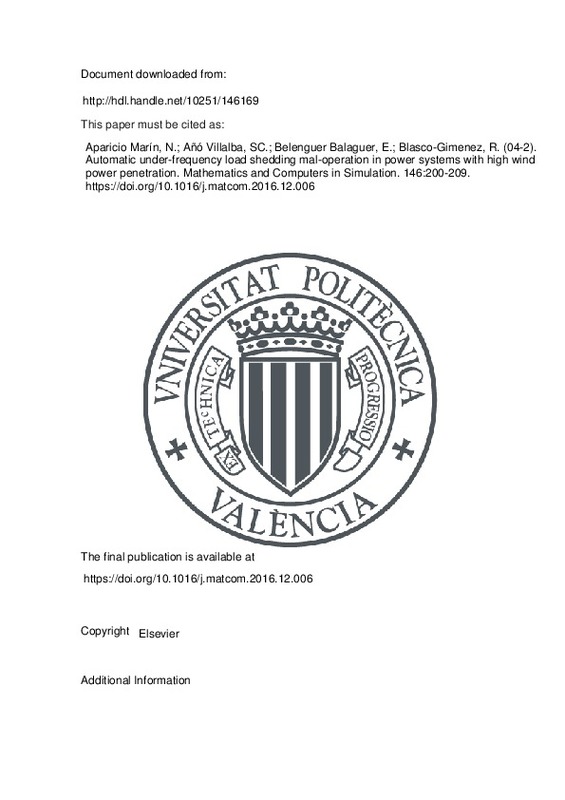JavaScript is disabled for your browser. Some features of this site may not work without it.
Buscar en RiuNet
Listar
Mi cuenta
Estadísticas
Ayuda RiuNet
Admin. UPV
Automatic under-frequency load shedding mal-operation in power systems with high wind power penetration
Mostrar el registro sencillo del ítem
Ficheros en el ítem
| dc.contributor.author | Aparicio Marín, Nestor
|
es_ES |
| dc.contributor.author | Añó Villalba, Salvador Conrado
|
es_ES |
| dc.contributor.author | Belenguer Balaguer, Enrique
|
es_ES |
| dc.contributor.author | Blasco-Gimenez, Ramon
|
es_ES |
| dc.date.accessioned | 2020-06-12T03:33:31Z | |
| dc.date.available | 2020-06-12T03:33:31Z | |
| dc.date.issued | 2018-04 | es_ES |
| dc.identifier.issn | 0378-4754 | es_ES |
| dc.identifier.uri | http://hdl.handle.net/10251/146169 | |
| dc.description.abstract | [EN] Countries with a limited interconnection capacity suffer substantial frequency variations after large incidents so they use automatic under-frequency load shedding schemes to arrest the frequency decay. Some of these countries such as Portugal, Spain and Ireland also have very high wind penetrations. This can cause additional frequency excursions due to generation time variability but also to the fact that variable speed wind turbines do not add directly their inertia to the power system. Thus several transmission system operators have announced new grid codes requiring wind turbines to provide frequency response. In some scenarios, however, wind energy support may be detrimental to frequency control because it generates an extra energy that reduces decay and derivative but that cannot be maintained over time. These lower values of frequency decay and derivative are currently expected after a reduced incident or when conventional generation, which can maintain the extra generation, provides frequency support, so lead to low or no load shedding. This paper has studied, in particular, the effect of wind generation emulating inertia. A reduction of frequency derivative is achieved, which looks positive at first, but in some cases leads to initial smaller load shedding than the incident requires. A reduced frequency derivative triggers less under-frequency relays as if there were a significant amount of conventional generation that is online. However, this generation has been substituted by wind generation emulating inertia, and as it can maintain extra generation over time, the frequency continues to decay until the shedding of the next load step. As a result there is an excessive frequency deviation and an incorrect load shedding for the magnitude of the initial disturbance. In order to prevent this problem, automatic under frequency load shedding settings may need readjustment when a large amount of wind generation provides frequency support. (C) 2017 International Association for Mathematics and Computers in Simulation (IMACS). Published by Elsevier B.V. All rights reserved. | es_ES |
| dc.description.sponsorship | The present work was supported by the Spanish Ministry of Economy and Competitivity and European Union FEDER funds under grant DPI2014-53245-R and by the Universitat Jaume I through project number P1 . 1B2015-42. Part of this work was done by Nestor Aparicio during a visit to University College Dublin, which was supported by the Spanish Ministry of Education, Culture and Sport under grant Jose Castillejo CAS14/00384. | es_ES |
| dc.language | Inglés | es_ES |
| dc.publisher | Elsevier | es_ES |
| dc.relation.ispartof | Mathematics and Computers in Simulation | es_ES |
| dc.rights | Reserva de todos los derechos | es_ES |
| dc.subject | Wind energy | es_ES |
| dc.subject | Under-frequency load shedding | es_ES |
| dc.subject | Frequency control | es_ES |
| dc.subject | Power system simulation | es_ES |
| dc.subject.classification | INGENIERIA DE SISTEMAS Y AUTOMATICA | es_ES |
| dc.subject.classification | INGENIERIA ELECTRICA | es_ES |
| dc.title | Automatic under-frequency load shedding mal-operation in power systems with high wind power penetration | es_ES |
| dc.type | Artículo | es_ES |
| dc.identifier.doi | 10.1016/j.matcom.2016.12.006 | es_ES |
| dc.relation.projectID | info:eu-repo/grantAgreement/UJI//P1.1B2015-42/ | es_ES |
| dc.relation.projectID | info:eu-repo/grantAgreement/MECD//CAS14%2F00384/ES/CAS14%2F00384/ | es_ES |
| dc.relation.projectID | info:eu-repo/grantAgreement/MINECO//DPI2014-53245-R/ES/INTEGRACION DE FUENTES DE ENERGIA RENOVABLES Y CONTROL DE FLUJOS DE POTENCIA EN REDES HVDC MEDIANTE CONVERTIDORES MODULARES MULTI-NIVEL/ | es_ES |
| dc.rights.accessRights | Abierto | es_ES |
| dc.contributor.affiliation | Universitat Politècnica de València. Departamento de Ingeniería Eléctrica - Departament d'Enginyeria Elèctrica | es_ES |
| dc.contributor.affiliation | Universitat Politècnica de València. Departamento de Ingeniería de Sistemas y Automática - Departament d'Enginyeria de Sistemes i Automàtica | es_ES |
| dc.description.bibliographicCitation | Aparicio Marín, N.; Añó Villalba, SC.; Belenguer Balaguer, E.; Blasco-Gimenez, R. (2018). Automatic under-frequency load shedding mal-operation in power systems with high wind power penetration. Mathematics and Computers in Simulation. 146:200-209. https://doi.org/10.1016/j.matcom.2016.12.006 | es_ES |
| dc.description.accrualMethod | S | es_ES |
| dc.relation.publisherversion | https://doi.org/10.1016/j.matcom.2016.12.006 | es_ES |
| dc.description.upvformatpinicio | 200 | es_ES |
| dc.description.upvformatpfin | 209 | es_ES |
| dc.type.version | info:eu-repo/semantics/publishedVersion | es_ES |
| dc.description.volume | 146 | es_ES |
| dc.relation.pasarela | S\325549 | es_ES |
| dc.contributor.funder | Universitat Jaume I | es_ES |
| dc.contributor.funder | Ministerio de Economía y Empresa | es_ES |
| dc.contributor.funder | European Regional Development Fund | es_ES |
| dc.contributor.funder | Ministerio de Educación, Cultura y Deporte | es_ES |







![[Cerrado]](/themes/UPV/images/candado.png)

